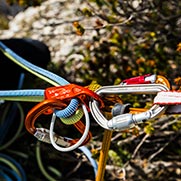Multi-pitch rappelling with a single rope
Depending on the rappel lengths, descending a few pitches can be accomplished with just the single rope, or with blocked rappels using a single rope and retrieval cord. For long rappel sequences, half or twin ropes are more efficient and help reduce the chance of user error.
Warnings
- Carefully read the Instructions for Use used in this technical advice before consulting the advice itself. You must have already read and understood the information in the Instructions for Use to be able to understand this supplementary information.
- Mastering these techniques requires specific training. Work with a professional to confirm your ability to perform these techniques safely and independently before attempting them unsupervised.
- We provide examples of techniques related to your activity. There may be others that we do not describe here.
Go directly to
Rappelling on a doubled rope
When the rappel length does not exceed half the rope’s total length, it is possible to rappel using just the single rope.
With a REVERSO type descender + friction hitch
Thread the rope through the rappel ring and even-up the two strands coming out of the anchor. Rappel as you would with half ropes.
With a GRIGRI
With a GRIGRI, it is not possible to rappel on the two strands coming out of the anchor. So one must rappel on a single strand, blocked at the rappel ring by a knot attached to a locking carabiner.
Rappel only on the strand opposite the knot block; the other strand is used only for retrieving the rope.
WARNING: the knot should be bigger than the rappel ring. If the knot goes through the ring, the fall will be stopped, but rope retrieval will be complicated.
Note: the knot slightly reduces the amount of available rope, and thus the maximum rappel length.
Note: A knot at the end of the rope is a necessary precaution in a variety of situations (e.g. long rappel, poor visibility, fatigue).
Petzl recommends that the rappel setup always be secured with a locking carabiner clipped to the rope, to back up the knot block.
There is a risk of the knot passing through the ring, even if the block seems secure.
Rappelling on a rope with a knot block at the anchor + rope retrieval cord
When the rappel length exceeds half the rope’s total length, a rope retrieval cord must be used.
In this configuration, the rappel is done only on the single rope with the GRIGRI or REVERSO (with backup device or friction hitch).
The rope must be rigged to the anchor with a blocking technique (knot block at the rappel ring attached to a locking carabiner) and attached to a retrieval cord.
Do not descend on the retrieval cord; it is only used to retrieve the rope.
1. Setting up the rappel
Each of the techniques below has advantages and disadvantages. Each user must adapt their technique depending on the terrain, their equipment and their own risk assessment.
Examples of blocking the rope
- Blocked on a small ring with backup. If the knot goes through the ring, the fall will be stopped, but rope retrieval will be complicated.
- The next rappel cannot be set up until the rope has been fully retrieved.
- Bulky: more likely to get the rope stuck
- Blocked without a rope-joining knot, with auto-locking carabiner. If the knot goes through the ring, the fall will be stopped, but rope retrieval will be complicated.
- The next rappel can be set up without threading the rope through the ring.
- With a large ring, risk of poor carabiner positioning and/or stuck rope.
Note: A knot at the end of the rope is a necessary precaution in a variety of situations (e.g. long rappel, poor visibility, fatigue).
Petzl recommends that the rappel setup always be secured with a locking carabiner clipped to the rope, to back up the knot block. There is a risk of the knot passing through the ring, even if the block seems secure.
Warning:
- The difference in diameter between the ropes may require a special joining knot (e.g. flat overhand bend with stopper knot). See the Instructions for Use.
- Blocking techniques are cumbersome; beware of sticking the rope: if the single rope gets stuck out of reach, the retrieval cord can not be used to belay for the recovery.
- The techniques presented above are not suitable for the rapid execution of a long series of rappels, as they require threading the entire rope through the rappel ring after it has been retrieved, or retying knots.
2. Rappelling and rope retrieval
Before un-tethering from the anchor, put your body weight on your rappel system and verify that it is properly set up.
Take care to rappel on the correct strand. Do not rappel on the cord.
The retrieval cord is used to retrieve the rope. So it’s important to keep it with you at all times during the descent.
To keep the wind from taking it, or to prevent it from getting out of reach on an offset rappel:
- With a GRIGRI: clip the cord to your belay loop with a quickdraw.
- With a REVERSO: pass the cord through the second rope slot.
Rope retrieval is done using the cord.
In the event of difficulty pulling on the cord (small diameter, friction...), use an ascender for better grip (BASIC, ASCENSION, TIBLOC).








